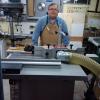Great news! I need to check my fence being square to the table too. I wanted to last night, after reading Don's post, when I got home, but my time evaporated quickly when I walked into the house.  Glad the problem is solved. I have a decent square from Rockler, but I'm sure it's not perfect either. Hope it's close. Amazing what quality alignment tools can do for you, huh? Jim.
Glad the problem is solved. I have a decent square from Rockler, but I'm sure it's not perfect either. Hope it's close. Amazing what quality alignment tools can do for you, huh? Jim.
Coolmeadow Setters...Exclusively Irish! When Irish Eyes are smiling....They're usually up to something!!
Home of Irish Setter Rescue of North Texas.
No, I'm not an electrician. Any information I share is purely what I would do myself. If in doubt, hire an electrician!
Member of the G0691 fan club!
At a minimum, I'm Pentatoxic...Most likely I'm a Pentaholic. There seems to be no known cure. Pentatonix, winners of The Sing Off, s3.





 Reply With Quote
Reply With Quote
 Glad the problem is solved. I have a decent square from Rockler, but I'm sure it's not perfect either. Hope it's close. Amazing what quality alignment tools can do for you, huh? Jim.
Glad the problem is solved. I have a decent square from Rockler, but I'm sure it's not perfect either. Hope it's close. Amazing what quality alignment tools can do for you, huh? Jim.





